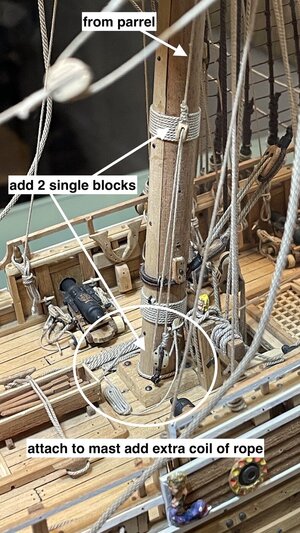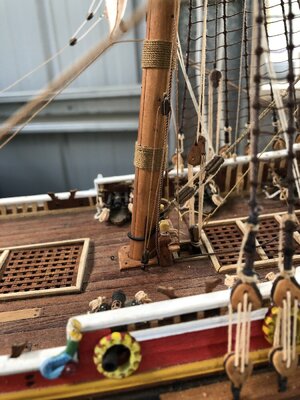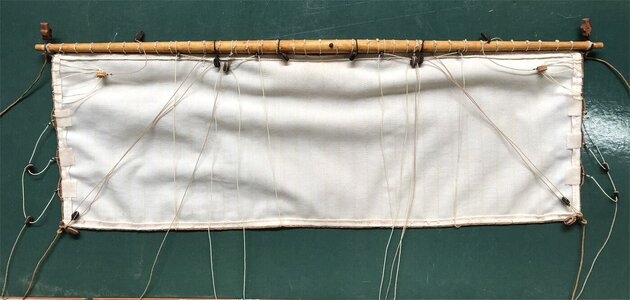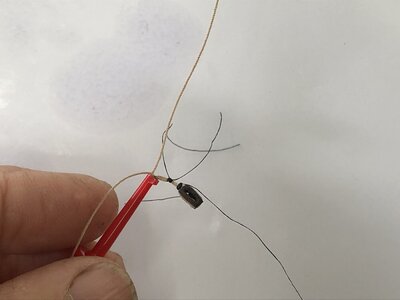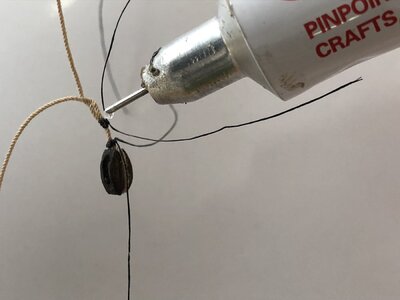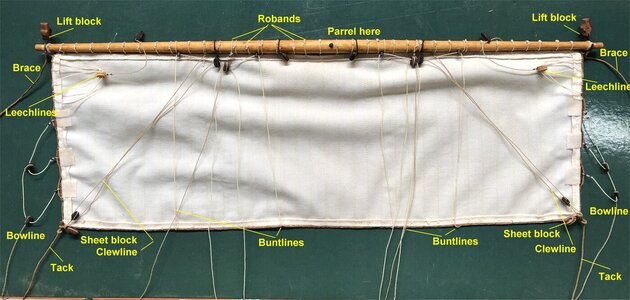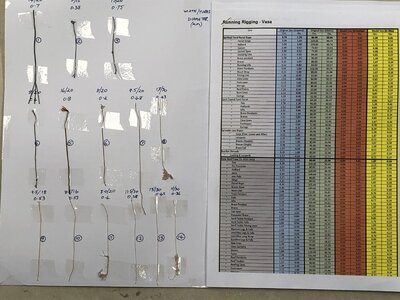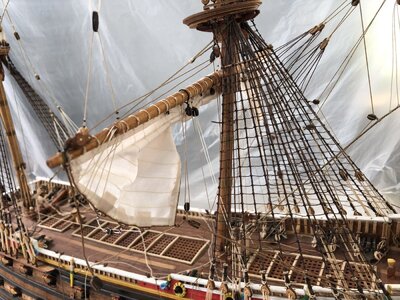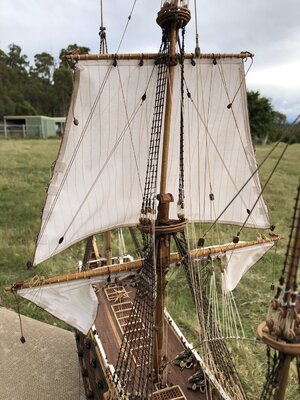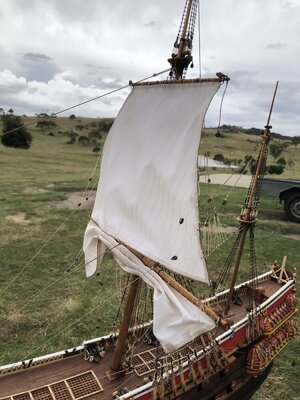Sorry to take so long to upgrade my build log - A lot happening in my life at the moment, and although I have been putting some time in to the Vasa, I am finding that the running rigging with sails is taking a really long time. I have so far got a fair way along with the setting up of two sails - The mainsail (furled), and the Main Topsail. In a previous post, I have said that I am only going to rig the sails as was thought to be set on the ship, when she sank - A total of four likely, but with the mainsail possibly furled.
I have decided on starting with the mainmast sails, as these are at the centre of the ship, and so, any additional rigging will impact on these being rigged if they came after. My thinking is to use the installation order of lower sails to upper, and then centre to foremast, and then mizzen. In this way, although I will be working with existing lines, the rope clutter at deck level should be more manageable as I work upwards. Similarly as I move from mainmast to foremast or mizzen, I should be working away from the already installed mainsails. I am not sure if this is the normal approach, but so far, it is working for me.
The next thing is that I have noticed, a lot of builders recommend placing as many ropes and rigging to their yards, before they are fitted to the mast. While this is good advice, the problem is, how long do you make your lines, before they are cut and reasonably accurate when installed. If they are short, it is really inconvenient to have to undertake rigging on the ship (although it is inevitable), and prone to upsetting existing rigging. If you get around this problem, by attaching lines to the yards, that are excessively long before installing, this is OK, but you use a huge amount of unwanted rope. Below is a picture of the mainsail with most of the rigging attached. Note that my mainsail is to be furled, and as such, it is only about 2/3 of the height it should be. If it's height is not reduced, there is too much fabric in the furl and it's hard to get tight enough.
View attachment 281032
As an example, I have rigged the bowlines for the mainsail and main topsail. I thought I had the length correct when I was pre-attaching them, but I soon realised that in practice, these lines, which run forward (near to the foot of the foremast), would require an additional two blocks with a hook, to be belayed to a deck-mounted eye. So, although the line was attached, the yard was secured around the mainmast, I still had to modify the rig, by adding two blocks and a pulley system, four times (for each bowline), while the lines were on the ship.
Attaching blocks or parts while the rigging is on the ship, needs to be done carefully, but it can be managed. I find the small, electronic spring-loaded hooks excellent for this. This picture below shows a line which is in mid air and suspended from the fore topmast yard, and requiring a block. The red hook holds the line and block in place while I wrap the enclosing line to be tight.
View attachment 281030
I like to do every join of rigging which is under tension with two wrappings of securing line (as you can see above). Too many times I have had a rope or block pull out when a single wrapping has been used only. Once I have the two wrappings in place, I then add a small amount of G-S Hypo cement (which dries effectively clear and invisibly into the rope), to secure the joint, and then I trim off any excess and wrapping (see below).
View attachment 281033
For each sail there is a significant list of lines required. These include:
- Robands (to secure the sail to the yard)
- Sheets
- Braces
- Tacks
- Clewlines
- Bowlines
- Buntlines (there may be a number of these per sail)
- Leechlines (or Martinets which may have a few attachment points)
- Halyards (for hoisting)
- Parrel lines (for tightening/loosening the parrels)
- Lifts
So, you can see it is quite a list. For most of these, they are also BOTH starboard and port, so the work has to be done twice for each sail. In the mainsail as shown above, I have added labels to the same sail and show below:
View attachment 281036
One other consideration too, is that for each of the rigging lines, the diameter of the various lines needs to be different, depending on the amount of strain the line may be under. Obviously, the greater the strain, the greater and stronger the line needs to be. There are a number of excellent spreadsheets for obtaining an estimate of the scaled size of the ropes required for the different applications. I have especially liked
Masting and Rigging for Period Ship Models spreadsheet.
From this, and because I am making my own rope, I have created a 'book' of rope sizes for different applications on the ship. I have printed reference sheets which indicate the line location for each sail/yard/rigging, and then a relatively wide range of ropes with an index showing:
- The turns/distance, to calculate the rope size (diameter) in millimetres (Australia is metric)
- The calculated diameter
- A key to refer to the initial thread source I have used.
View attachment 281041
From this, I simply look up the scaled diameter required in the reference list, and then select the rope, as required. There is a bit of an issue with colour, as I have tended to use light brown or creamy white, but the size is near correct. I am constantly amazed at the amount of rope needed, so the rope supply and my ropewalk are in frequent use.
Regards,
PeterG









